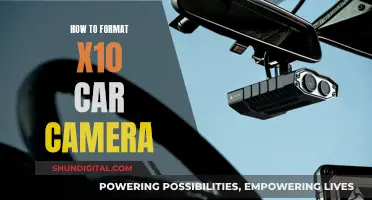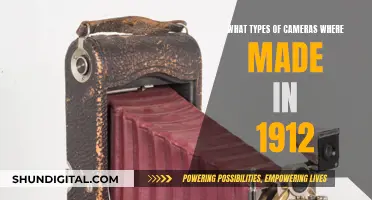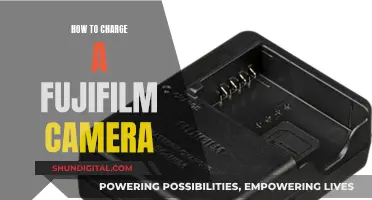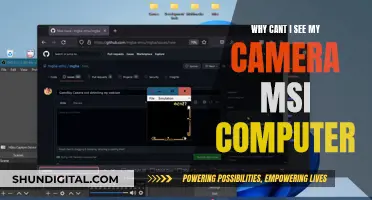
Traffic cameras, including speed cameras, are a common feature on roads in the UK and other countries. While there are guidelines and recommendations regarding their placement and appearance, the requirements for marking them vary. In the UK, for example, there is no legal mandate for warning signs or markings for speed cameras, and they can be placed in unmarked vehicles. However, the Department for Transport advises that speed camera housings should be coloured yellow and easily visible, and mobile speed camera operators should wear fluorescent clothing. In contrast, other countries, such as those in Europe, may have laws prohibiting the use of certain types of speed camera detectors or jammers. It is essential to be aware of the specific regulations in your region to ensure compliance and avoid penalties.
| Characteristics | Values |
|---|---|
| Housing Colour | Yellow |
| Housing Obstruction | Not obscured by trees, bushes or signs |
| Visibility | Visible from 60m away in 40mph or less zones and 100m for all other speed limit zones |
| Sign Placement | Only in areas where camera housings are sited or where mobile cameras are operating |
| Mobile Camera Operators | Wear fluorescent clothing, and their vehicles should be marked with reflective strips |
| Camera Site Reviews | Every 6 months to ensure cameras are visible and signposted |
| Marking | No legal requirement for marking |
What You'll Learn

Speed cameras don't need to be marked by law
Speed cameras are a permanent fixture on the roads in the UK, introduced in the early 1990s to tackle speeding and the serious threat of injury and death that it carries. While there are guidelines and recommendations for the placement and appearance of speed cameras, it is not a legal requirement for them to be marked or signposted.
The Department for Transport (DoT) guidelines state that speed cameras should be housed in yellow boxes, which should be visible and not obscured by trees, bushes, or signs. The cameras themselves should be visible from 60 metres away in a 40 mph zone, or 100 metres in other zones. However, these guidelines are not mandatory, and there is no legal requirement for speed cameras to be marked or signposted.
Mobile speed cameras, which are often operated by local police forces, also do not need to be marked or signposted. While the DoT recommends that operators wear fluorescent clothing and use vehicles marked with reflective strips, this is not a legal requirement.
The absence of a speed camera sign does not mean that there is no camera present, and drivers should always obey the speed limits. Speed cameras can be placed in areas with a history of accidents to help reduce speed-related injuries and deaths.
While speed camera signs are often placed as a courtesy by the police to warn drivers, they are not required by law. Speeding is illegal, and cameras have the right to be present and enforce the law, regardless of whether there is a sign.
In summary, while there are guidelines and recommendations for the placement and appearance of speed cameras, they are not legally required to be marked or signposted. Drivers should always obey speed limits and be vigilant, as cameras can be placed anywhere to enforce road safety and prevent speeding-related incidents.
Charging Your 4K Ultra HD Camera: A Step-by-Step Guide
You may want to see also

Speed camera signs are a courtesy
The Department for Transport (DoT) guidelines state that speed cameras should be visible and housed in yellow, but this is not a legal mandate. The DoT recommends that speed cameras be positioned in areas with a history of speeding-related accidents, and indeed, many speed cameras are placed in these locations. However, this is not always the case, and mobile speed cameras, in particular, may be placed in unmarked vehicles without any warning signs.
While speed camera signs are not required, they do serve a purpose. They are often placed in areas where accidents are more common, acting as a caution to drivers to stay within the speed limits. Additionally, with the advancements in technology, sat navs can now detect upcoming speed cameras and alert drivers, even in the absence of signs. Nevertheless, it is always advisable to remain vigilant and adhere to the speed limits, as cameras may be present without any prior warning.
It is worth noting that while speed camera signs may not always indicate the presence of a camera, the absence of a sign does not imply the absence of a camera. The authorities are well within their rights to place cameras without warning, and drivers can be fined for speeding, regardless of whether a sign was posted or not. In conclusion, while speed camera signs are a courtesy, they should not be relied upon as a guarantee of no speed cameras, and the best course of action is to always follow the speed limits.
Camera Car Driver's Guide to Payroll Management
You may want to see also

Speed cameras don't always flash
In the UK, speed cameras are an integral part of the road network and are used to enforce speed limits. While they are not the most popular piece of safety equipment, they do help to deter speeding and improve road safety.
The use of speed cameras is governed by guidelines from the Department for Transport. These guidelines state that speed cameras must be housed in yellow casing and be clearly visible from a certain distance, depending on the speed limit of the zone they are in. However, it is not a legal requirement for speed cameras to be marked or visible.
There are several types of speed cameras in use, including fixed and mobile units. Fixed speed cameras, such as the Gatso and Truvelo, are usually mounted on poles at the side of the road and are easily identifiable by their yellow casing. Mobile speed cameras are typically operated from marked police vehicles or vans and can be set up in various locations, including at the side of the road, in laybys, or on bridges.
While most speed cameras use a visible flash to capture images of speeding vehicles, not all speed cameras flash. Some newer speed cameras, such as the ultra speed camera being trialled in Manchester, do not use a flash at all. This makes it more difficult for motorists to tell if they have been caught speeding.
In addition, some types of speed cameras, such as the Truvelo, use a special filter over the flash to prevent dazzling oncoming drivers. As a result, the flash from a Truvelo camera may not be visible, especially during the daytime or in good lighting conditions.
Handheld speed guns used by police officers also do not require a flash as they use radar and laser technology to measure a vehicle's speed and trigger the officer to pull over the speeding car.
So, while a speed camera flash is a common indication that a vehicle's speed has been captured, it is not always a guarantee. Motorists should be aware that even if they do not see a flash, their speed may still be recorded and they could receive a speeding fine.
Plugging Your Camera: Computer Ports and Compatibility
You may want to see also

Speed cameras can be hidden
Mobile speed cameras, which are often placed in accident hotspots, also have guidelines regarding their appearance and placement. Operators of these cameras should wear fluorescent clothing and be clearly visible, and their vehicles should have reflective strips.
While these guidelines are in place, they are not a legal requirement, and there are no strict legal requirements for speed cameras to be visible. If a speed camera does not meet these guidelines, it is still possible to be convicted of speeding. However, there is a chance that evidence from a hidden speed camera may not be admissible in court, as there are strict rules regarding what evidence can be used against a defendant.
In addition, while warning signs are not mandatory, their presence often acts as a deterrent to slow drivers down.
Bullet Surveillance Cameras: What Are They and Why Use Them?
You may want to see also

Speed cameras can be monitored by hidden police cars
Speed cameras are a permanent fixture on UK roads and are used to monitor compliance with speed limits. They can be fixed or mobile, with the latter being hand-held, tripod-mounted, or vehicle-mounted. Mobile speed cameras are usually run by local police forces and are positioned in places where there is a history of road traffic incidents.
While there are guidelines regarding the placement of speed cameras, there is no legal requirement for them to be visible. Speed cameras should be painted yellow, but this is also not a legal requirement. They don't need to be visible for a driver to get fined. However, mobile speed camera operators should be visible and wear fluorescent clothing, and their vehicles should be marked with reflective strips.
The use of speed cameras has been shown to be effective in reducing accidents and injuries. The UK Department for Transport estimated that cameras led to a 22% reduction in personal injury collisions and a 42% reduction in people being killed or seriously injured at camera sites.
Adjusting Your Computer Camera: Easy Tips for Better Framing
You may want to see also
Frequently asked questions
No, there is no law that states that traffic cameras have to be marked or signposted in any way. However, the Department for Transport does recommend that speed camera housings be coloured yellow, and that they should be visible from 60m away in 40mph or less zones and 100m for all other speed limit zones.
Mobile speed camera operators should be visible and wearing fluorescent clothing. Their vehicles should also be marked with reflective strips.
No, not all speed cameras flash. For example, front-facing Truvelo Combi cameras use a filter to prevent their flash from dazzling drivers.







